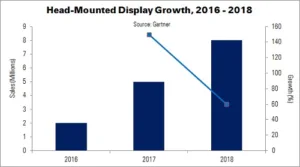At a press event in Taipei, Gartner research director Brian Blau stated that the total unit sales for virtual reality, augmented reality and other smart glass apps will grow to 2 million units by 2016 and 5 million in 2017 followed by 8 million in 2018. This includes all head mounted displays. They conclude that by 2018 more than 25 million head mounted displays will have been sold.
According to this math, a total of 10 million head mounted displays have been sold so far and are in the hands of users. This includes all Google Glass devices as well as the many other devices from Epson, Vuzix and others. Gartner saw an increase in HMD sales in 2014 and believes that this represents the strongest sales in this technology so far. The analyst sees this development as a move from the fringe of the markets to an entry into the mainstream consumer market.

The company continued that, before 2014, the main application for head mounted displays were specialty applications such as industrial design, military training and simulation. Of course, this changed to a certain degree when Google Glass entered the market and pushed for mass market adoption. So far this initiative has failed as Google Glass has been discontinued for adoption in the general public space.
Gartner believes that this will change as soon as HMD’s are offered as stylish, consumer grade video eyeglasses. In addition, companies such as Sony, Samsung and HTC (there are more offering such devices) need to provide quality devices together with compelling applications to enhance the user experience.
Analyst Comment
I have seen and tried many head mounted displays and personally found most of them more of a scientific project than a consumer device. First of all the image quality often left much to be desired and secondly the use cases were often weak and were met with resistance because of social awkwardness. This is by no means a good start for the use of this technology in consumer markets.
Gartner sees the style of the device and video use as the keys to consumer adoption. Interestingly it did not mention gaming as a potential driver. Looking at the interest of the media in virtual reality and Oculus Rift in particular, it seems that other players like Facebook and Microsoft have other ideas for this technology. Gaming, video conferencing, social media and other applications seem to be more attractive for these companies.
The current market trend seems to favor industrial and military applications. While it is possible that these applications will generate these kind of sales numbers, this still does not mean that the technology is ready for the mass market. Oculus Rift may be released later this year and change all that. So far the only application I have seen working very well was for drawing attention to a booth at MWC. People lined up to watch some content. The interest of people is there (or at least curiosity – Man. Ed.), but there is a long way to go to mass market adoption. – NH

